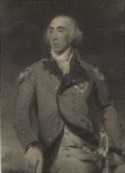Clement-Jones family - Person Sheet
Clement-Jones family - Person Sheet
Spouses
Notes for Charles GREY 1st EARL GREY
One of the most important British generals of the 18th century. He was the fourth son of Sir Henry Grey, Bt., of Howick in Northumberland.
Charles received his first military commission in 1744. In the Seven Years' War, he served as adjutant in the staff of Duke Ferdinand of Brunswick and later of Wilhelm, Count of Schaumburg-Lippe during the Spanish invasion of Portugal (1762).
During the American War of Independence he was one of the more successful army leaders. He earned the nickname "No-flint Grey" after the Paoli Massacre nighttime attack of 1777, before which he had collected flints from the muskets of his troops before they engaged the American revolutionaries using bayonets, thus maintaining the element of surprise. Grey used the same tactic in 1778 in the Baylor Massacre. He later was appointed commander-in-chief of the British troops in America, but hostilities were concluded before he could take command.
In acknowledgment of his service, Grey was raised in January 1801 to the peerage as Baron Grey of Howick. In 1806, he was created Earl Grey and Viscount Howick. He died the next year, at the age of 78.
In 1762, Grey married Elizabeth Grey (1744-1822), the daughter of George Grey of Southwick (1713-1746), their sons were:
• Charles Grey, 2nd Earl Grey, British statesman and prime minister after whom Earl Grey tea is named.
• George Grey (1767 - 1828), whose daughter Hannah Jean married Sir Henry Thompson, 3rd Baronet
• William Grey (1777 - 1817)
• Edward Grey (1782 - 1837)
He was also an ancestor of Prime Ministers Anthony Eden and Alec Douglas-Home, and of Eliza Courtney and Diana, Princess of Wales.
Charles received his first military commission in 1744. In the Seven Years' War, he served as adjutant in the staff of Duke Ferdinand of Brunswick and later of Wilhelm, Count of Schaumburg-Lippe during the Spanish invasion of Portugal (1762).
During the American War of Independence he was one of the more successful army leaders. He earned the nickname "No-flint Grey" after the Paoli Massacre nighttime attack of 1777, before which he had collected flints from the muskets of his troops before they engaged the American revolutionaries using bayonets, thus maintaining the element of surprise. Grey used the same tactic in 1778 in the Baylor Massacre. He later was appointed commander-in-chief of the British troops in America, but hostilities were concluded before he could take command.
In acknowledgment of his service, Grey was raised in January 1801 to the peerage as Baron Grey of Howick. In 1806, he was created Earl Grey and Viscount Howick. He died the next year, at the age of 78.
In 1762, Grey married Elizabeth Grey (1744-1822), the daughter of George Grey of Southwick (1713-1746), their sons were:
• Charles Grey, 2nd Earl Grey, British statesman and prime minister after whom Earl Grey tea is named.
• George Grey (1767 - 1828), whose daughter Hannah Jean married Sir Henry Thompson, 3rd Baronet
• William Grey (1777 - 1817)
• Edward Grey (1782 - 1837)
He was also an ancestor of Prime Ministers Anthony Eden and Alec Douglas-Home, and of Eliza Courtney and Diana, Princess of Wales.


